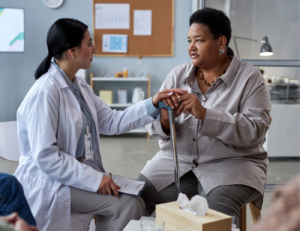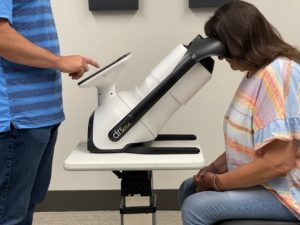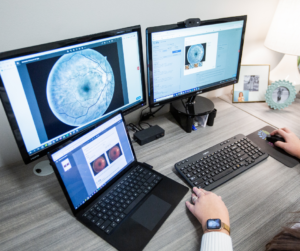How IRIS Positively Impacts CHC and FQHC Optometry Providers

Compared to their urban-dwelling counterparts, Americans who live in rural areas are far less likely to receive important healthcare services of nearly every kind, including eye care. They’re also more likely to develop a range of common health conditions and diseases, including diabetes. Moreover, they are at increased risk of developing diabetes-related complications that threaten their eye health, such as diabetic retinopathy, the leading cause of preventable blindness in the United States.

Preventative care, such as regular eye exams and screenings, coupled with efforts to educate diabetes patients on the importance of diabetic retinopathy exams, dramatically reduces their likelihood of developing diabetic retinopathy and experiencing related vision loss. In many rural communities, residents depend on Community Health Centers (CHC optometry) and Federally Qualified Health Centers (FQHC optometry) for vision care. These are federally funded health centers that bring a range of medical care to underserved communities at reduced or no cost to the patients.
The IRIS platform is emerging as an essential tool for enhancing rural eye care by connecting patients with these vital screenings. The platform integrates with CHC optometry and FQHC practices to enable you to perform retinal screenings that can prevent vision loss due to diabetic retinopathy.
Understanding the Landscape of Rural Eye Care
According to the National Institute for Health Care Management, over 46 million Americans—between 15 and 20% of the population—live in rural settings as of 2020. In the wake of the COVID-19 pandemic, such settings have experienced immense growth as more and more Americans trade big cities and other high-population locations for rural areas. Unfortunately, the healthcare industry hasn’t followed them there.
Rural populations are medically underserved communities that face a range of challenges, including:
- Lack of health insurance: Approximately one out of every three rural Americans carries only partial health insurance; an additional 10% live without health insurance of any kind. At the same time, rural Americans are more likely than other demographics to forgo necessary medical care for financial reasons.
- A scarcity of nearby eye care facilities: Although it is somewhat easier for rural Americans to access primary health care services close to home, they have a much harder time when it comes to eye care, as ophthalmologists tend to practice in urban settings. This scarcity makes it difficult for primary care physicians to schedule referral appointments for their patients, who may be unable to attend anyway due to distance.
- Substandard fluency in health education: A number of social and cultural factors that often characterize rural areas result in deficient eye health literacy. Examples include cultural biases, language barriers, and knowledge gaps regarding conditions that cause vision loss, like diabetic retinopathy.

Faced with a lack of nearby eye care providers, rural Americans must resort to alternative options to meet their eye care needs. Primary care physicians, hospitals, and in-home healthcare providers, along with CHC optometry and FQHC optometry clinics, are common sources.
What Services Are Typically Offered in Rural Eye Care Clinics?
When eye care is available in rural areas, it often falls within a limited range of services. Understaffed clinics and a dearth of sufficient equipment and other amenities are often a cause. The cost of certain services, including preventative retinal scans, is another. This is especially true in rural communities with large populations of Medicare and Medicaid patients, where eye care providers may struggle to obtain subsidized insurance reimbursements.
As such, rural eye care may be limited only to those services that are within the scope of small, one-doctor practices, such as common eye infections, uveitis, and large central foreign bodies, which are common examples.

FQHC optometry clinics are an important access point for eye care in underserved areas, but CHC optometry services can also vary from clinic to clinic. Many clinics offer only routine eye care, such as vision screenings and prescription updates. Others may offer routine and immediate care to address eye trauma, infections, and sudden vision loss.
Even when CHC optometry services are available in rural clinics, adequate preventative care may fall by the wayside. Medical eye exams and screenings for conditions like glaucoma, cataracts, and diabetic retinopathy are not always among the available services. This emphasizes the importance of solutions like the IRIS platform that facilitate diabetic retinopathy screenings.
The Significance of Accessible Eye Care in Rural Communities
A scarcity of local eye care services is a major reason that rural Americans face an enhanced risk of poor eye health, including problems like vision loss caused by age and/or disease-related conditions like diabetic retinopathy.
Rural Americans are less likely to receive regular eye examinations and preventative screenings. Because they routinely go without comprehensive eye care and check-ups, they face an increased risk of developing conditions that remain undiagnosed and untreated. This often leads to higher rates of poor eye health and partial or full vision loss.

For people with diabetes in particular, the risks may be even greater due to the correlation between certain diabetes medications that threaten eye health. For example, studies show a link between the popular diabetes medication Ozempic and decreased eye health, including:
- Enhanced macular degeneration
- Blurred vision
- Enhanced symptoms of diabetic retinopathy
Additionally, people in rural areas already face higher rates of a range of eye health issues. Partial vision loss or low vision, preventable blindness caused by diabetic retinopathy, and refractive errors are among the most common, in addition to conditions caused by accidental injuries, such as burns or damage that results from surgical complications. This underscores the pertinence of expanding routine eye care services in rural areas as well as diabetic retinopathy preventative care.
Enhancing Rural Eye Care with IRIS
The IRIS solution helps rural healthcare providers perform vision-saving retinal screenings, whether they work as primary care practitioners, in hospitals and community clinics, or provide in-home care.

The IRIS solution helps doctors detect early signs of diabetic retinopathy and diagnose it while there’s still time to implement proactive care that can save a patient’s eyesight. With the IRIS solution, doctors can use a fundus camera suited to their practice to perform retinal screenings. The images are then uploaded to the IRIS platform, where a licensed and qualified professional physician from the IRIS Reading Center (IRC) reviews the patient’s images and, if necessary, makes a diagnosis. The results are then sent back to the physician so that the patient can be referred to an appropriate eye care specialist for treatment.
With IRIS’s newest service, IRIS Now, the process is even easier. IRIS Now helps smaller practices integrate the IRIS platform into their practice and quickly onboard their team so you can start screening patients right away.
Explore the IRIS Platform & Safeguard Your Patients’ Sight
IRIS provides a solution that works with a variety of fundus cameras, ranging in price and portability. The solution integrates with any EMR, enabling automated patient identification and order creation. Image enhancement software is automatically applied to each retinal image, giving eye care providers a heightened ability to identify potential disease and severity.

If you’re a healthcare provider in a rural area, act now to find out how integrating IRIS and IRIS Now into your practice can help you help your community see better. Reach out today for more information.
FAQs
Who provides rural eye care?
In many rural areas, residents turn to their primary care doctors or their local hospital systems for eye care. Where available, Community Health Centers provide FQHC optometry services.
What services are typically offered in rural eye care clinics?
Rural eye care clinics are often restricted to providing limited services. Patients may only have access to routine eye care, including basic vision and non-diagnostic disease screenings. These clinics may also offer immediate care for eye injuries, infections, and sudden vision loss. In rarer cases, preventative eye care is available.
Why is rural eye care important?
Rural communities are often underserved when it comes to healthcare, including vision care. This leaves them at higher risk of developing vision-threatening conditions. Bringing rural eye care, especially preventative care, to rural communities is an important step toward combatting this.
What are some common eye health concerns in rural areas?
Common eye health concerns in rural areas include limited access to care clinics, diminished service offerings, and a lack of education surrounding eye health.
Are there any financial assistance programs available for rural eye care?
Some communities may have access to CHC optometry and FQHC optometry services. These institutions provide federally-funded eye care in rural areas at no or reduced cost to patients.
SM 174, Rev A
Get started with IRIS today.
Want to know if IRIS is right for you? Schedule a one-on-one consultation with our team. We’re here to help.